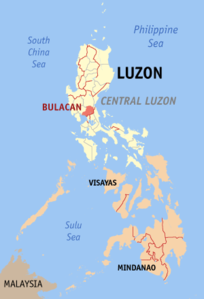Bulacan
| Basic data | |
|---|---|
| Region : | Central Luzon |
| Capital : | Malolos |
| Population : | 3,292,071 August 1, 2015 census
|
| Population density : | 1177 inhabitants per km² |
| Area : | 2,796.10 km² |
| PSGC : | 031400000 |
| Official website: | http://www.bulacan.gov.ph/ |
| structure | |
| - Highly urbanized cities | |
| - provincial cities | 3 |
| - municipalities | 21st |
| - Barangays | 569 |
| - electoral districts | 4th |
| Location of the province in the Philippines | |

|
|
Coordinates: 15 ° 0 ' N , 121 ° 0' O Bulacan , very rarely Bulakan , a Philippine province in the region Central Luzon on the main island Luzon . The capital of the province is Malolos . In 2015, 3,292,071 people lived in the province of 2,796.10 km². Due to its proximity to the capital Manila , the local population mainly speaks Tagalog . Besides Tagalog, Kapampangan and English are the most commonly used languages.
geography
Geographical location
Bulacan is north of Metro Manila and the Rizal Province . It is also surrounded by the provinces of Pampanga in the west, Nueva Ecija in the north, and Aurora and Quezon in the east. In the southwest, Bulacan has a connection to the South China Sea via Manila Bay .
To the west and south of Bulacan lies the fertile plains of Central Luzon. The two rivers Angat and Pampanga flow through it . The Sierra Madre form the highlands in the east of the province, in which the Angat reservoir and the nature reserve Angat Watershed Forest Reserve are located in this area and form the largest water resource in the region. The highest point of Bulacan is Mount Oriod at 1,170 meters.
In the east of the province are the Candaba river marshes , which represent a unique ecosystem.
climate
November to April is usually dry, while the rest of the year it is wet. The northeast monsoons occur between October and January and bring moderate rainfall. Due to the Sierra Madre in the east there is always a very dry period between February and April , despite the trade winds . From May to September, the monsoons come from the southwest, which often brings with it a large number of storms or strong typhoons. The hottest month is May with an average temperature of 29.7 ° C. February was the coldest at 18.1 ° C.
Cities and municipalities
Bulacan is divided into three cities and 21 municipalities, which in turn in 569 barangays split:
Cities:
Municipalities:
economy
Industry
More and more industries are emerging due to the proximity to Metro Manila. Many companies are building factories and operations in Bulacan. The production of leather, fireworks, ceramics, textiles and shoes have gained in importance.
Agriculture
Agriculture is still the main source of income in rural areas. Mainly rice, corn , vegetables and mangoes are grown.
history
Little is known about pre-Hispanic history, the area is said to have belonged at least partially to the Luzon Empire . The name of the province comes from the word "Bulak", which means cotton in Tagalog ; once the most important product in the province. The first documented settlements in Bulacan were small fishing villages on the Bay of Manila. After the Spanish conquest in the 16th century , the interior was also more heavily populated. The settlements are now the city center of Bulacan, Calumpit (founded in 1572) and San Rafael (founded in 1750). 1848 was San Miguel continued the province, which previously Pampanga belonged.
Bulacan was one of the first eight provinces to resist Spanish rule during the Philippine Revolution . The first Provisional Republic of the Philippines was proclaimed in the caves of Biak-na-Bato in July 1897, the Republic of Biak-na-Bato , and the first constitution of the Philippines was passed there on November 1st. However, the republic was dissolved on December 15, 1897 with the signing of the Treaty of Biak-na-Bato in San Miguel between the Filipino and Spanish parties. The second phase began on June 12, 1898 , when the Philippines declared themselves independent in Kawit and the Revolutionary Congress was opened on September 15 in the Church of Barasoain in Malolos City . On January 23, 1899, the First Philippine Republic was constituted in Malolos and Emilio Aguinaldo became its first president and Malolos briefly became the capital. The Congreso Revolucionario (Revolutionary Assembly) met in the Malolos Cathedral until March 29, 1899 in it.
When the Americans formed a civil government in the Philippines, the first election in the country was held on May 6, 1899 in the town of Baliuag. In addition, some significant Filipinos, such as Gregorio del Pilar and Francisco Baltazar , were born in the province .
education
There are several colleges and universities in the province. In addition to Metro Manila, Bulacan offers the largest range of these educational institutions. There are three universities in Bulacan: Baliuag University , Bulacan State University , Polytechnic University of the Philippines and Centro Escolar University .
National parks
Personalities
- Marcelo H. del Pilar , nationalist and editor of the propaganda newspaper La Solidaridad .
- Gregorio del Pilar , nephew of Marcelo del Pilar and general during the Philippine-American War
- Deodato Arellano Filipino revolutionary and first president of the Katipunan
- Soc Rodrigo , former Filipino Senator
